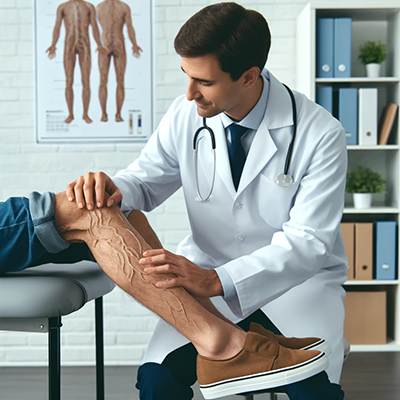Contents
Welcome to natural remedies for varicose veins. Millions of people would like the answer to the essential question of (how to get rid of varicose veins naturally?) First, before we begin with the natural varicose vein treatments, let us learn about the symptoms and causes of this condition.
Varicose veins are distended veins, mainly in the calves and inner thighs of the legs. They are enlarged, lumpy, bulging, and bluish. Small ones can appear spidery and red. There may be aching or tiredness, a feeling of fullness in the limbs. The skin may have a tense or burning sensation.
Muscle cramps may occur, primarily at night. Bleeding beneath the skin may cause it to discolor (bluish to light brown). Veins may be abnormally large, bulging, and lumpy-looking.
Causes of Varicose Veins

The valves of the veins no longer function optimally. They have become stretched from excess pressure. The valves in the vein prevent blood from flowing backward and do not work correctly. The deep veins are surrounded by muscles that keep them in shape. Those close to the surface (saphenous veins) develop these problems. So much blood collects that it leaks out into surrounding tissue.
Contraceptive medications can induce varicose veins and hormonal vasodilation just before menstruation. They can occur during pregnancy (especially during the first three months). About fifteen percent of Americans experience the condition; many are women. Overweight people are the most significant risk. Additionally, heavy lifting is another factor.
When varicose veins occur in and around the anus, they are known as hemorrhoids. Straining at the stool due to a lack of fiber in the diet causes constipation. It can manifest as varicose veins, diverticulosis, hemorrhoids, hiatus hernia, and phlebitis. Spider veins are not very pleasant to look at, but does not cause any problems.
Natural Remedies for Varicose Veins

Herbs
- For years, horse chestnut seeds have been used in Germany to treat varicose veins and hemorrhoids. The active ingredient, aescin, strengthens capillaries and reduces fluid leakage. Use the standardized extract.
- An herbal wash that relieves varicose veins: Mix equal parts sweet flag root, thyme leaves, nettle leaves, fruit, and horse chestnut leaves.
- Witch Hazel is an excellent herbal wash. It is a soothing astringent that strengthens blood vessels. White oak bark is another useful astringent herb.
- Applying aloe vera gel is soothing to the veins.
- Apply fresh wood sorrel leaves to the area with extended veins. Cover with large cabbage leaves, and fasten with an ace bandage.
- Taking bromelain reduces the risk of clot formation.
Here are some other helpful substances:
- Lemon peel contains flavonoids, including rutin, which reduce blood vessel permeability.
- Bilberry stimulates the new capillary formation
- Ginkgo improves circulation.
- Both pansy flowers and violets contain rutin and are safe to eat. Add them to your salads.
- Drinking corn milk or dandelion tea helps the kidneys eliminate excess fluid, thus reducing tissue swelling.
- According to Dr. Christopher, making and drinking sassafras tea and using it to wash the legs is beneficial.
- Apply hot applications of tansy tea on large veins. Replace them when they become cool. Cover with wool or plastic to keep them hot and wet.
Diet
- Drink at least forty-eight ounces of water daily.
- Take vitamin C (500 to 1000 mg three times a day), vitamin E (200 to 400 IU daily), and flaxseed oil (1 Tbsp. daily).
- Consume a high-fiber diet that is low in refined starches and fats. Eat plenty of fresh fruits and vegetables. Abstain from animal products as much as possible. Eat legumes, nuts, and whole grains.
- If you are overweight, losing some pounds is helpful.
Other Tips on How to Reduce Varicose Veins Naturally

- Avoid wearing clothing that constricts blood flow. However, moderate pressure on the veins (elastic stockings) is helpful.
- Avoid crossing your legs. It adds pressure to the veins.
- Elevate your feet while watching television or reading, and elevate your legs above your heart for twenty minutes daily.
- Walking is the best exercise for your legs.
- While on lengthy trips, walk around now and then.
- Avoid standing in one place for too long. If you have to do so, rise on your toes occasionally, wiggle your toes, and move a little from time to time.
- Sleep with your feet raised slightly above the level of the heart. But do not attempt this if you have heart problems.
- If confined to a bed, move your extremities frequently to improve general circulation.
- In the mornings, walk barefoot on the cool, wet grass. Quickly dry and put on socks and shoes.
- Avoid scratching the itchy skin above varicose veins. Doing so can lead to surface ulcers and bleeding.
DISCLAIMER: All content on this website is presented solely for educational and informational objectives. Do not rely on the information provided as a replacement for advice, diagnosis, or treatment from a qualified medical expert. If you are pregnant, nursing, or have any preexisting medical concerns, talk to your doctor before using any herbal or natural medicines.
References
- Vance Ferrell Harold M. Cherne, M.D. The Natural Remedies Encyclopedia [Book]. – Altamont, TN: Harvestime Books, 2010. – Vol. Seventh Edition: 7: pp. 535, 536. [natural remedies for varicose veins]
- Pittler MH, Ernst E. Horse chestnut seed extract for chronic venous insufficiency. Cochrane Database Syst Rev. 2012 Nov 14;(11):CD003230. doi: 10.1002/14651858.CD003230.pub4. PMID: 23152218.
- National Institutes of Health: https://www.nccih.nih.gov/health/horse-chestnut
- Medical News Today: https://www.medicalnewstoday.com/articles/321703
- Cleveland Clinic: https://health.clevelandclinic.org/varicose-vein-remedies
- Verywell Health: https://www.verywellhealth.com/natural-treatments-for-varicose-veins-89260
- Mayo Clinic: https://www.mayoclinic.org/diseases-conditions/varicose-veins/symptoms-causes/syc-20350643
